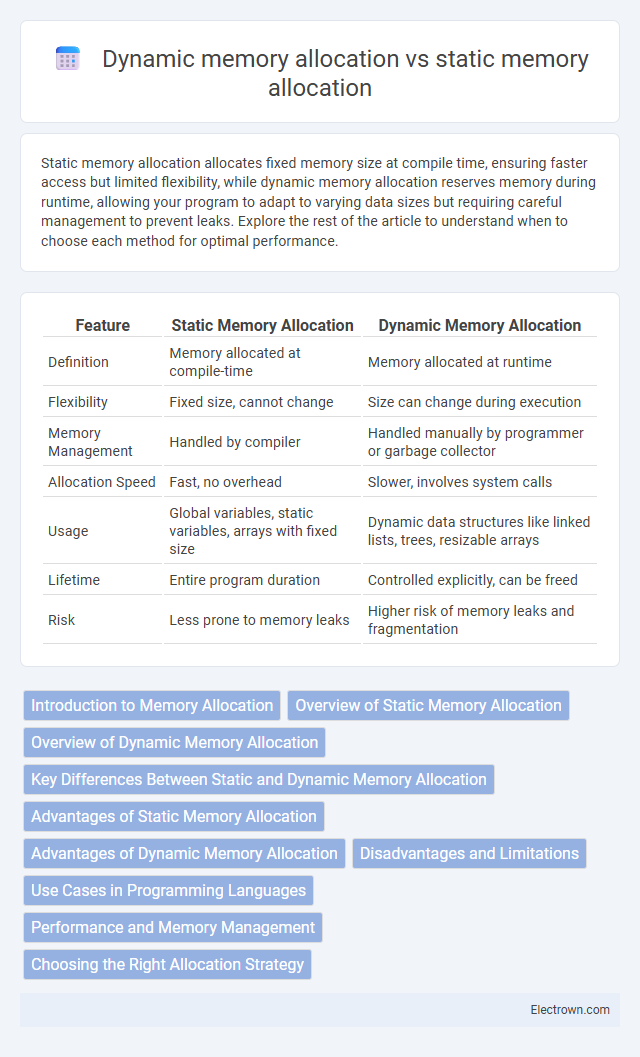Static memory allocation allocates fixed memory size at compile time, ensuring faster access but limited flexibility, while dynamic memory allocation reserves memory during runtime, allowing your program to adapt to varying data sizes but requiring careful management to prevent leaks. Explore the rest of the article to understand when to choose each method for optimal performance.
Table of Comparison
| Feature | Static Memory Allocation | Dynamic Memory Allocation |
|---|---|---|
| Definition | Memory allocated at compile-time | Memory allocated at runtime |
| Flexibility | Fixed size, cannot change | Size can change during execution |
| Memory Management | Handled by compiler | Handled manually by programmer or garbage collector |
| Allocation Speed | Fast, no overhead | Slower, involves system calls |
| Usage | Global variables, static variables, arrays with fixed size | Dynamic data structures like linked lists, trees, resizable arrays |
| Lifetime | Entire program duration | Controlled explicitly, can be freed |
| Risk | Less prone to memory leaks | Higher risk of memory leaks and fragmentation |
Introduction to Memory Allocation
Static memory allocation reserves fixed memory space at compile time, ensuring faster access and simpler management but limiting flexibility for varying data sizes. Dynamic memory allocation, performed at runtime using functions like malloc() or new, allows programs to request memory as needed, optimizing resource usage and accommodating unpredictable workloads. Understanding the differences between these methods is crucial for efficient memory management and application performance.
Overview of Static Memory Allocation
Static memory allocation reserves a fixed amount of memory during compile time, ensuring predictable memory usage and faster access speeds. It assigns memory for all variables and data structures before program execution, typically in the data or BSS segment. This method reduces runtime overhead but lacks flexibility, as memory sizes cannot be changed dynamically.
Overview of Dynamic Memory Allocation
Dynamic memory allocation in programming allows the allocation of memory at runtime using functions like malloc(), calloc(), realloc(), and free() in languages such as C and C++. This approach provides flexibility by enabling programs to request and release memory as needed, optimizing resource utilization and accommodating variable data sizes. Unlike static memory allocation, which assigns fixed memory sizes during compile-time, dynamic allocation adapts to changing application requirements, improving efficiency and scalability.
Key Differences Between Static and Dynamic Memory Allocation
Static memory allocation assigns fixed memory size at compile time, ensuring faster access but limited flexibility. Dynamic memory allocation reserves memory at runtime using functions like malloc or new, providing adaptability for varying data sizes. Static allocation uses stack memory, while dynamic allocation relies on heap memory, impacting performance and memory management complexity.
Advantages of Static Memory Allocation
Static memory allocation offers faster execution since memory is allocated at compile time, reducing runtime overhead and fragmentation risks. It provides a predictable memory footprint, enhancing stability and simplifying debugging in embedded systems or real-time applications. Your program benefits from improved performance and reliability when memory requirements are fixed and known in advance.
Advantages of Dynamic Memory Allocation
Dynamic memory allocation offers flexibility by allocating memory during runtime, which efficiently handles variable-sized data and optimizes resource usage. It supports complex data structures like linked lists and trees, enabling dynamic resizing that static allocation cannot provide. Your programs gain improved memory utilization and adaptability to changing data requirements through this method.
Disadvantages and Limitations
Static memory allocation limits flexibility by reserving fixed memory size at compile-time, leading to potential wastage or insufficient space during runtime. Dynamic memory allocation, while more adaptable, introduces overhead for management and risks memory fragmentation, leaks, and pointer errors. Both methods can impact application performance and reliability depending on the complexity and memory usage patterns.
Use Cases in Programming Languages
Static memory allocation is commonly used in embedded systems and real-time applications where predictability and speed are critical, as it reserves fixed memory size during compile time. Dynamic memory allocation suits applications with varying or unpredictable data sizes, such as in data structures like linked lists, trees, and graphs, often implemented in languages like C, C++, and Python. Programming languages like C utilize functions such as malloc() and free() for dynamic allocation, while languages like Java manage dynamic memory automatically through garbage collection.
Performance and Memory Management
Static memory allocation allocates fixed memory sizes at compile time, resulting in faster access speeds and predictable memory usage but lacks flexibility for varying data sizes. Dynamic memory allocation assigns memory at runtime, allowing efficient use of memory by allocating only what is needed, though it introduces overhead due to allocation and deallocation processes. Performance in static allocation benefits from minimal runtime management, while dynamic allocation offers superior memory management adaptability, particularly in applications with unpredictable or evolving data requirements.
Choosing the Right Allocation Strategy
Choosing the right memory allocation strategy depends on the application's predictability and resource management needs. Static memory allocation offers fixed size allocation at compile time, ensuring faster access and reduced overhead, ideal for systems with known resource limits. Dynamic memory allocation provides flexibility by allocating memory at runtime, suitable for applications with variable or unpredictable memory requirements, but it introduces overhead and potential fragmentation.
Static memory allocation vs dynamic memory allocation Infographic

 electrown.com
electrown.com